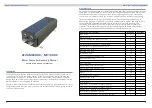
Zero Emission Vehicles Australia
Motor Controller Assembly Manual
Tech note: The busbars are made from aluminium, which is a good conductor of electricity,
but quickly builds up an oxide layer which is not a good conductor. So it helps to remove the
oxide then seal the surface from reoxidising using Noalox. When the busbars are screwed to the
circuit boards, the screw pressure forces the grease to the edges, to allow conduction under
the screws while also being sealed against future oxidation.
• The central busbar needs to be insulated from the screws using plastic
inserts, 5-6mm lengths cut from 6mm OD, 4mm ID tubing. This is a
common size for pneumatic tubing, which can be purchased from places
like Farnell / Element14 / Newark. Make sure none are over 6mm long or
they could prevent the busbar from making good contact with the circuit
boards - better to be a bit under 6mm than a bit over.
• Give the large exposed tracks on the power boards and cap boards a wipe to get rid of any
solder flux / grime, then assemble the power stage: Start with the heat block with power boards
attached, place longest busbar on B+ side, slide interface board onto header pins, slide middle
busbar through current sensor, place shortest busbar on B- side, then place capacitor boards
(noting polarity).
• Insert M4x16 socket head machine screws through all the holes in the capacitor boards (30
screws for MC600C, 48 screws for MC1000C). Fasten the middle row tightly into the heat
block - about as tight as you can comfortably go using a screwdriver, or something like 1Nm.
• Tilt the assembly onto its side, support with a block of wood or similar, then add M4 spring
washers and nuts to each of the screws protruding through the power boards. Hold each nut
using a socket wrench and tighten its associated screw, again to about 1Nm torque. Repeat for
other side (i.e screws through both B+ and B- busbars).
• Solder the pin headers connecting the interface board to the power boards, with a 90 degree
angle between the boards.
• The gate drive signal that passes along the power boards needs to be connected electrically
by bridging the groups of three pin headers. The resistor leg offcuts can be used to make 8-
10mm wire jumpers to join the boards as shown in the picture. Inspect the solder joints with a
loupe to ensure they are neat and tidy, as a bad solder joint could be fatal for the motor
controller.
7
8






